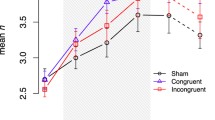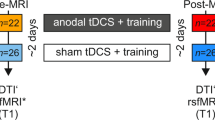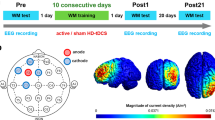Abstract
The capacity for transcranial direct current stimulation (tDCS) to increase learning and cognition shows promise for the development of enhanced therapeutic interventions. One potential application is the combination of tDCS with cognitive training (CT), a psychological intervention which aims to improve targeted cognitive abilities. We have previously shown that tDCS enhanced performance accuracy, but not skill acquisition, on a dual n-back working memory (WM) CT task over repeated sessions. In the current study, we investigated the optimal timing for combining tDCS with the same CT task to enhance within and between session performance outcomes across two daily CT sessions. Twenty healthy participants received in a randomised order 30 min of anodal tDCS to the left dorsolateral prefrontal cortex immediately before (‘offline’ tDCS) and during performance (‘online’ tDCS) on a dual n-back WM CT task, in an intra-individual crossover design. Analyses examined within and between session consolidation effects of tDCS on CT performance outcomes. Results showed that ‘online’ tDCS was associated with better within session skill acquisition on the CT task, with a significant difference found between conditions the following day. These results suggest that ‘online’ tDCS is superior to ‘offline’ tDCS for enhancing skill acquisition when combining anodal tDCS with CT. This finding may assist with the development of enhanced protocols involving the combination of tDCS with CT and other rehabilitation protocols.



Similar content being viewed by others
References
Alonzo A, Brassil J, Taylor JL, Martin D, Loo CK (2012) Daily transcranial direct current stimulation (tDCS) leads to greater increases in cortical excitability than second daily transcranial direct current stimulation. Brain Stimul 5:208–213
Andrews SC, Hoy KE, Enticott PG, Daskalakis ZJ, Fitzgerald PB (2011) Improving working memory: the effect of combining cognitive activity and anodal transcranial direct current stimulation to the left dorsolateral prefrontal cortex. Brain Stimul 4:84–89
Bai S, Dokos S, Ho K-A, Loo CK (2014) A computational modelling study of transcranial direct current stimulation montages used in depression. Neuroimage 87:332–344
Batsikadze G, Moliadze V, Paulus W, Kuo MF, Nitsche MA (2013) Partially non-linear stimulation intensity-dependent effects of direct current stimulation on motor cortex excitability in humans. J Physiol 591:1987–2000
Bolognini N, Vallar G, Casati C et al (2011) Neurophysiological and behavioural effects of tDCS combined with constraint-induced therapy in poststroke patients. Neurorehabil Neural Repair 25:819–829
Brunelin J, Mondino M, Gassab L et al (2012) Examining transcranial direct-current stimulation (tDCS) as a treatment for hallucinations in schizophrenia. Am J Psychiatry 169:719–724
Brunoni AR, Vanderhasselt MA (2014) Working memory improvement with non-invasive brain stimulation of the dorsolateral prefrontal cortex: a systematic review and meta-analysis. Brain Cogn 86:1–9
Brunoni AR, Valiengo L, Baccaro A et al (2013) The sertraline vs. electrical current therapy for treating depression clinical study: results from a factorial, randomized, controlled trial. JAMA Psychiatry 70:383–391
Bullard LM, Browning ES, Clark VP et al (2011) Transcranial direct current stimulation’s effect on novice versus experienced learning. Exp Brain Res 213:9–14
Cerruti C, Schlaug G (2008) Anodal transcranial direct current stimulation of the prefrontal cortex enhances complex verbal associative thought. J Cogn Neurosci 21:1980–1987
Ditye T, Jacobson L, Walsh V, Lavidor M (2012) Modulating behavioural inhibition by tDCS combined with cognitive training. Exp Brain Res 219:363–368
Fregni F, Boggio PS, Nitsche M et al (2005) Anodal transcranial direct current stimulation of prefrontal cortex enhances working memory. Exp Brain Res 166:23–30
Fridriksson J, Richardson JD, Baker JM, Rorde C (2011) Transcranial direct current stimulation improves naming reaction time in fluent aphasia: a double blind, sham controlled study. Stroke 42:819–821
Galvez V, Alonzo A, Martin D, Loo CK (2013) Transcranial direct current stimulation treatment protocols: should stimulus intensity be constant or incremental over multiple sessions? Int J Neuropsychopharmacol 16:13–21
Halko MA, Datta A, Plow EB et al (2011) Neuroplastic changes following rehabilitative training correlate with regional electrical field induced with tDCS. Neuroimage 57:885–891
Iyer MB, Mattu U, Grafman J et al (2005) Safety and cognitive effect of frontal DC brain polarization in healthy individuals. Neurology 64:872–875
Jaeggi SM, Buschkuehl M, Jonides J, Perrig WJ (2008) Improving fluid intelligence with training on working memory. Proc Natl Acad Sci USA 105:6829–6833
Javadi AH, Walsh V (2012) Transcranial direct current stimulation (tDCS) of the left dorsolateral prefrontal cortex modulates declarative memory. Brain Stimul 5:231–241
Kalu UG, Sexton CE, Loo CK, Ebmeier KP (2012) Transcranial direct current stimulation in the treatment of major depression: a meta-analysis. Psychol Med 42:1791–1800
Kincses TZ, Antal A, Nitsche MA, Bartfai O, Paulus W (2004) Facilitation of probabilistic classification learning by transcranial direct current stimulation of the prefrontal cortex in the human. Neuropsychologia 42:113–117
Leśniak M, Polanowska K, Seniow J, Czlonkowska A (2013) Effects of repeated anodal tDCS coupled with cognitive training for patients with severe traumatic brain injury: a pilot randomized controlled trial. J Head Trauma Rehabil. doi:10.1097/HTR.0b013e318292a4c2
Lindenberg R, Renga V, Zhu LL, Nair D, Schlaug G (2010) Bihemispheric brain stimulation facilitates motor recovery in chronic stroke patients. Neurology 75:2176–2184
Loo CK, Alonzo A, Martin DM et al (2012) Transcranial direct current stimulation for depression: 3-week, randomised, sham-controlled trial. Br J Psychiatry 200:52–59
Martin DM, Alonzo A, Mitchell PB et al (2011) Fronto-xtracephalic transcranial direct current stimulation as a treatment for major depression: an open-label pilot study. J Affect Disord 134:459–463
Martin DM, Alonzo A, Ho K et al (2013a) Continuation transcranial direct current stimulation for the prevention of relapse in major depression. J Affect Disord 144:274–278
Martin DM, Liu R, Alonzo A et al (2013b) Can transcranial direct current stimulation enhance outcomes from cognitive training: a randomized controlled trial in healthy participants. Int J Neuropsychopharmacol 16:1927–1936
Monte-Silva K, Kuo M, Hessenthaler S et al (2013) Induction of late LTP-like plasticity in the human motor cortex by repeated non-invasive brain stimulation. Brain Stimul 6:424–432
Mottaghy FM, Krause BJ, Kemna LJ et al (2000) Modulation of the neuronal circuitry subserving working memory in healthy human subjects by repetitive transcranial magnetic stimulation. Neurosci Lett 280:167–170
Mull BR, Seyal M (2001) Transcranial magnetic stimulation of left prefrontal cortex impairs working memory. Clin Neurophysiol 112:1672–1675
Nitsche MA, Paulus W (2000) Excitability changes induced in the human motor cortex by weak transcranial direct current stimulation. J Physiol 527:633–639
Nitsche MA, Paulus W (2001) Sustained excitability elevations induced by transcranial DC motor cortex stimulation in humans. Neurology 57:1899–1901
Ohn SH, Park CI, Yoo WK et al (2008) Time-dependent effect of transcranial direct current stimulation on the enhancement of working memory. NeuroReport 19:43–47
Oldfield RC (1971) The assessment and analysis of handedness: the Edinburgh inventory. Neuropsychologia 9:97–113
Park S, Seo J, Kim Y, Ko M (2013) Long-term effects of transcranial direct current stimulation combined with computer-assisted cognitive training in healthy older adults. NeuroReport. doi:10.1097/WNR.0000000000000080
Pirulli C, Fertonani A, Miniussi C (2013) The role of timing in the induction of neuromodulation in perceptual learning by transcranial electric stimulation. Brain Stimul 6:683–689
Rae C, Lee V, Ordidge R, Alonzo A, Loo C (2013) Anodal transcranial direct current stimulation increases brain pH and modulates bioenergetics. Int J Neuropsychopharmacol 16(8):1695–1706
Redick TS, Shipstead Z, Harrison TL et al (2013) No evidence of intelligence improvement after working memory training: a randomized, placebo-controlled study. J Exp Psychol Gen 142:359–379
Reis J, Schambra HM, Cohen LG et al (2009) Noninvasive cortical stimulation enhances motor skill acquisition over multiple days through an effect on consolidation. Proc Natl Acad Sci USA 106:1590–1595
Reis J, Fischer JT, Prichard G et al (2013) Time-but not sleep-dependent consolidation of tDCS-enhanced visuomotor skills. Cereb Cortex. doi:10.1093/cercor/bht208
Schambra HM, Mitsunari A, Luckenbaugh DA et al (2011) Probing for hemispheric specialization for motor skill learning: a transcranial direct current stimulation study. J Neurophysiol 106:652–661
Siebner HR, Lang N, Rizzo V et al (2004) Preconditioning of low-frequency repetitive magnetic stimulation with transcranial direct current stimulation: evidence for homeostatic plasticity in the human motor cortex. J Neurosci 24:3379–3385
Stagg CJ, Jayaram G, Pastor D et al (2011) Polarity and timing-dependent effects of transcranial direct current stimulation in explicit motor learning. Neuropsychologia 49:800–804
Stagg CJ, Lin RL, Mezue M et al (2013) Widespread modulation of cerebral perfusion induced during and after transcranial direct current stimulation applied to the left dorsolateral prefrontal cortex. J Neurosci 33:11425–11431
Teo F, Hoy KE, Daskalakis ZJ, Fitzgerald PB (2011) Investigating the role of current strength in tDCS modulation of working memory performance in healthy controls. Front Psychiatry 2:45
Zaehle T, Sandmann P, Thorne JD, Jäncke L, Herrmann CS (2011) Transcranial direct current stimulation of the prefrontal cortex modulates working memory performance: combined behavioural and electrophysiological evidence. BMC Neurosci 12:2
Acknowledgments
This study was made possible by funding from the University of New South Wales. Donel Martin has received financial support for tDCS research from a NARSAD Young Investigator Award.
Author information
Authors and Affiliations
Corresponding author
Additional information
Clinical Trials Registration: www.clinicaltrials.gov (ID: NCT01339585).
Rights and permissions
About this article
Cite this article
Martin, D.M., Liu, R., Alonzo, A. et al. Use of transcranial direct current stimulation (tDCS) to enhance cognitive training: effect of timing of stimulation. Exp Brain Res 232, 3345–3351 (2014). https://doi.org/10.1007/s00221-014-4022-x
Received:
Accepted:
Published:
Issue Date:
DOI: https://doi.org/10.1007/s00221-014-4022-x




